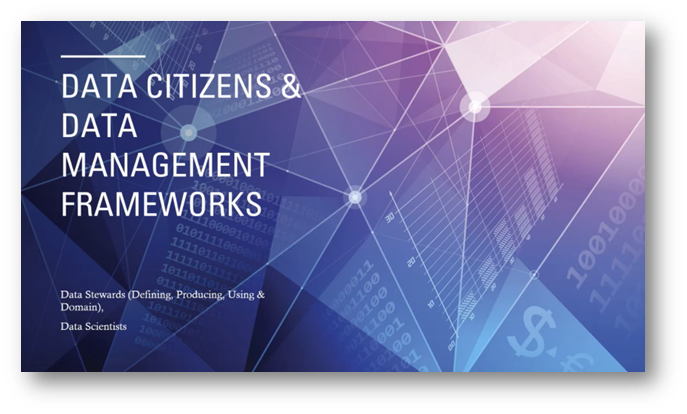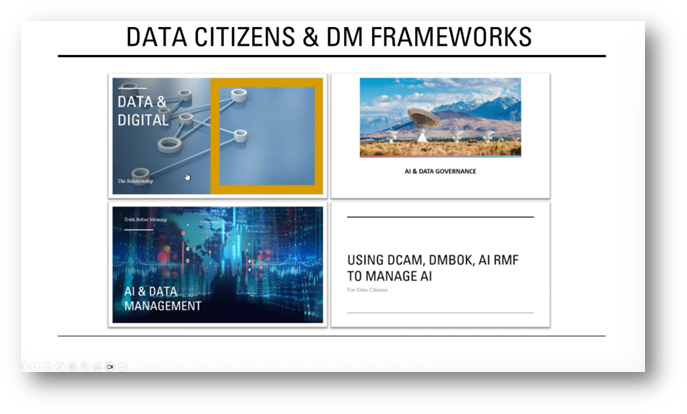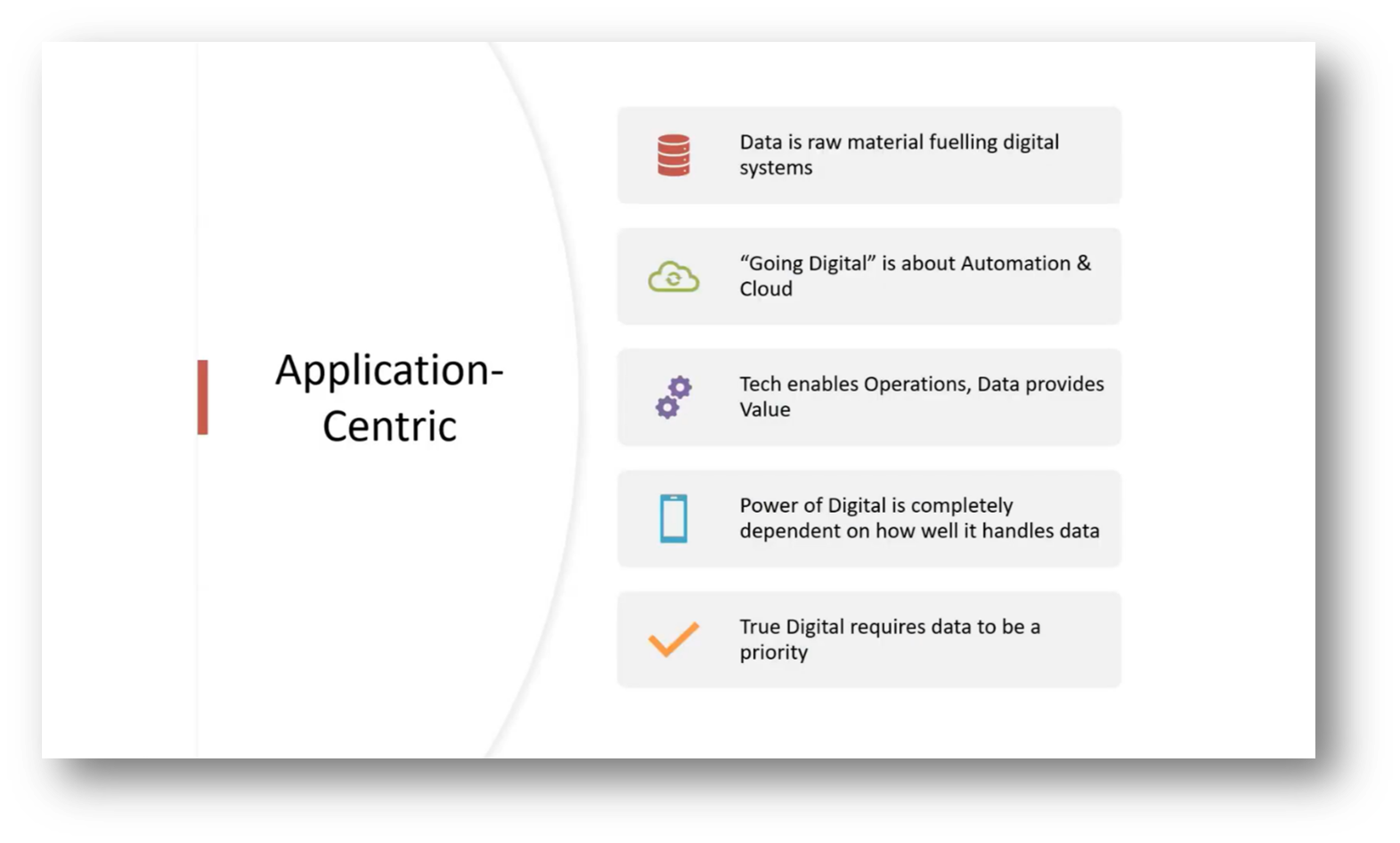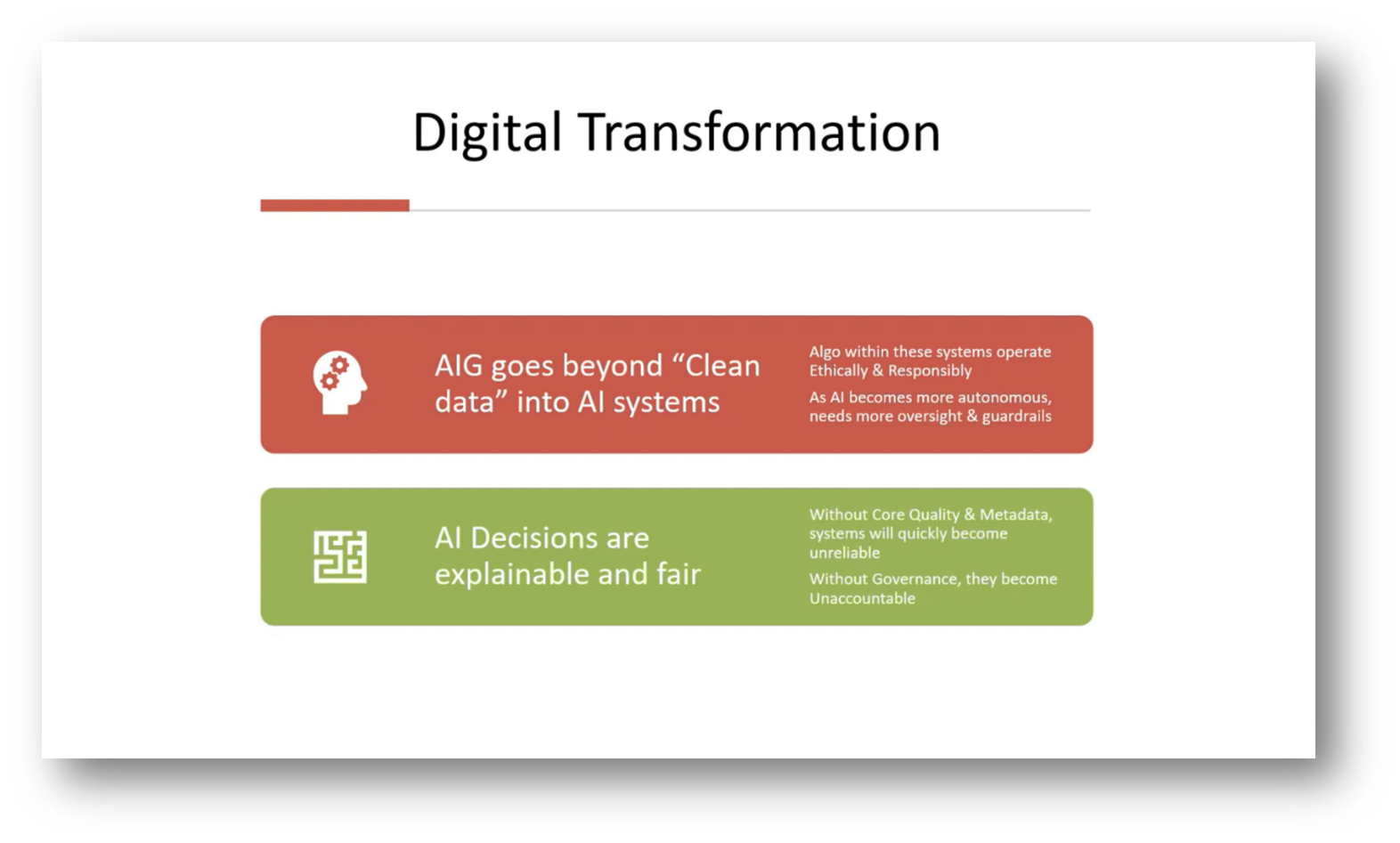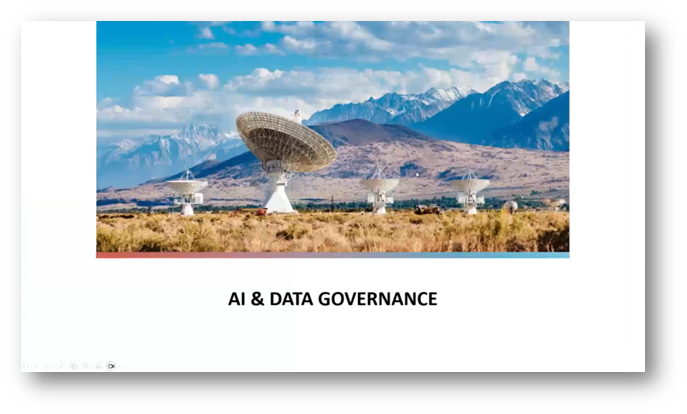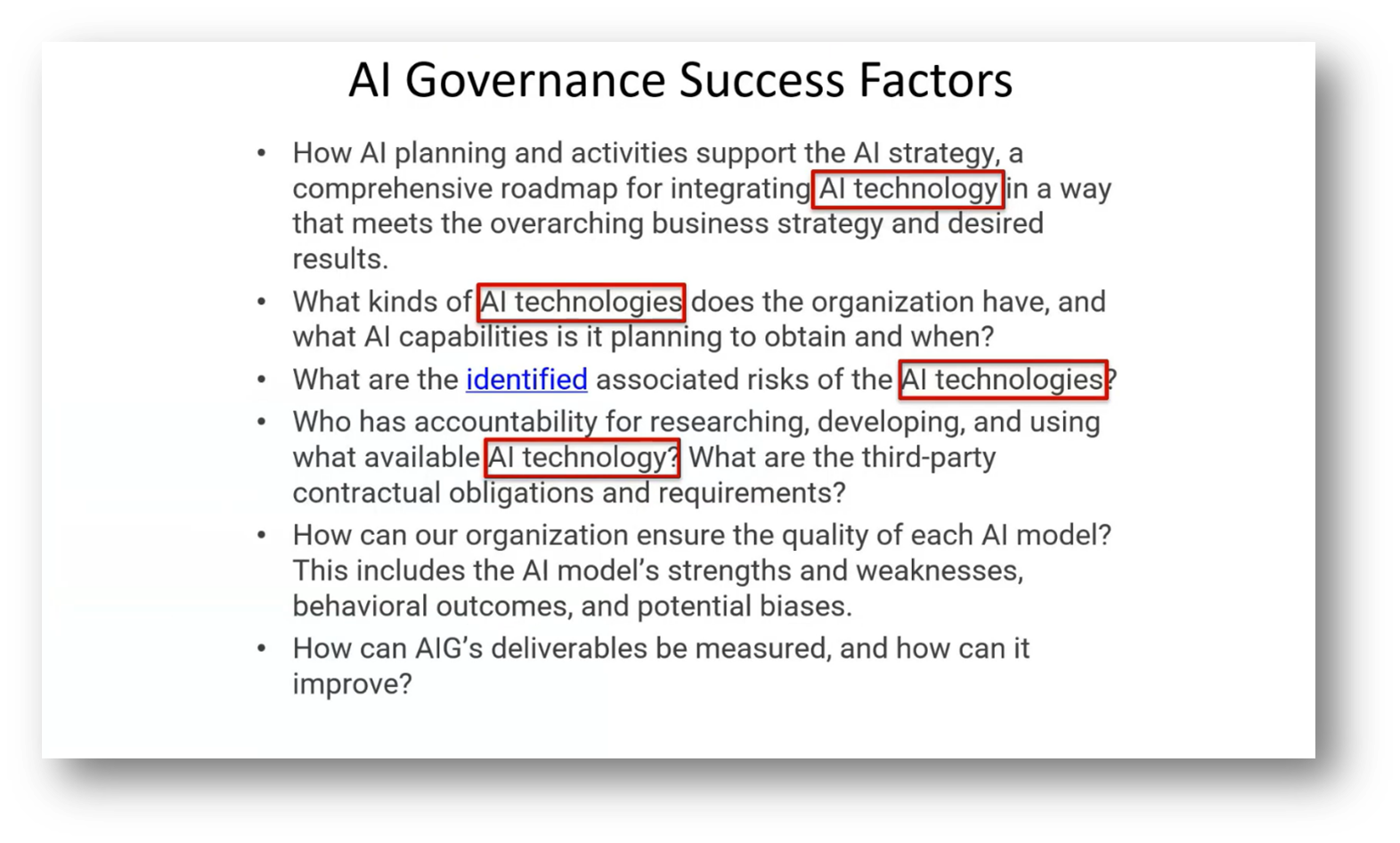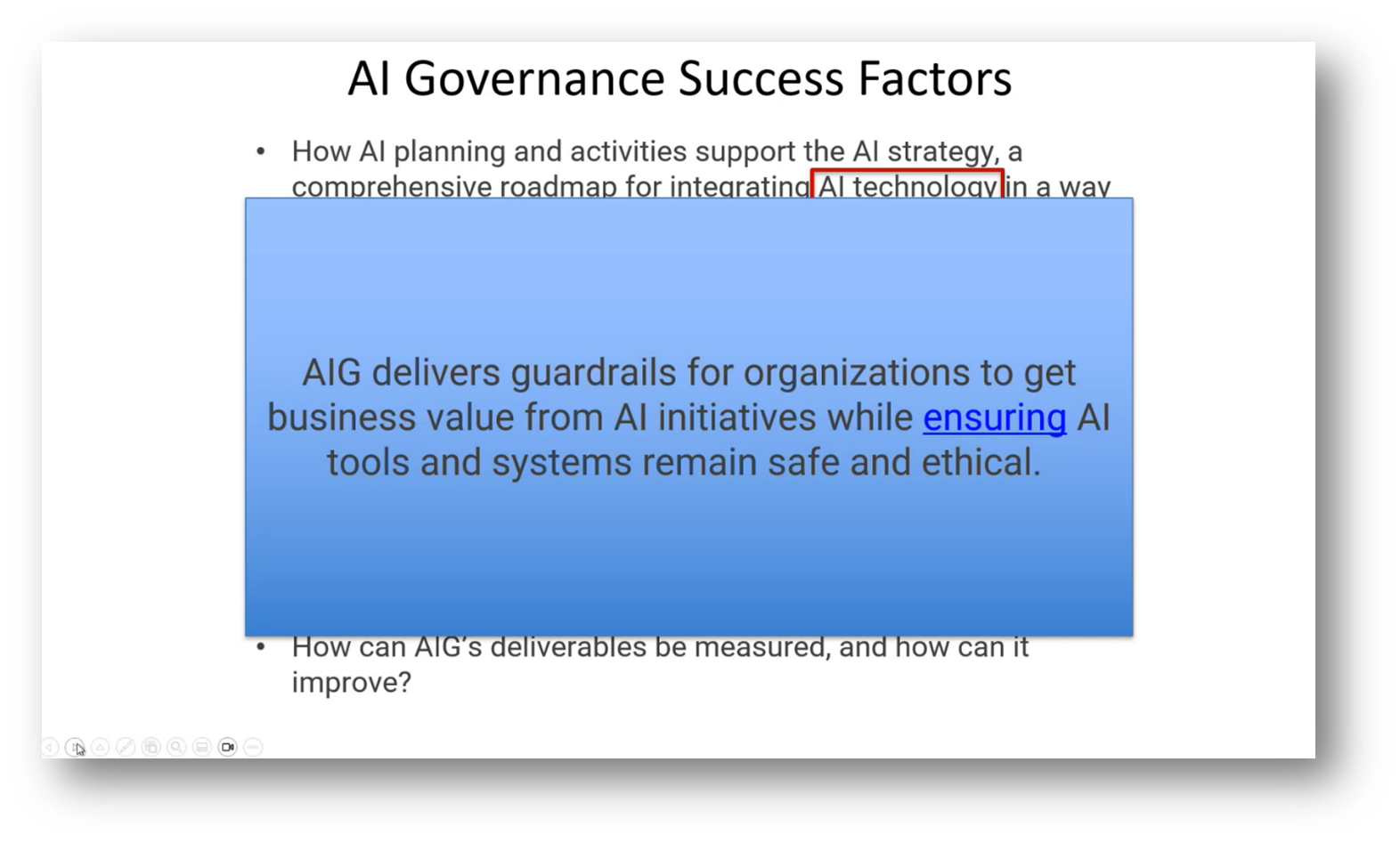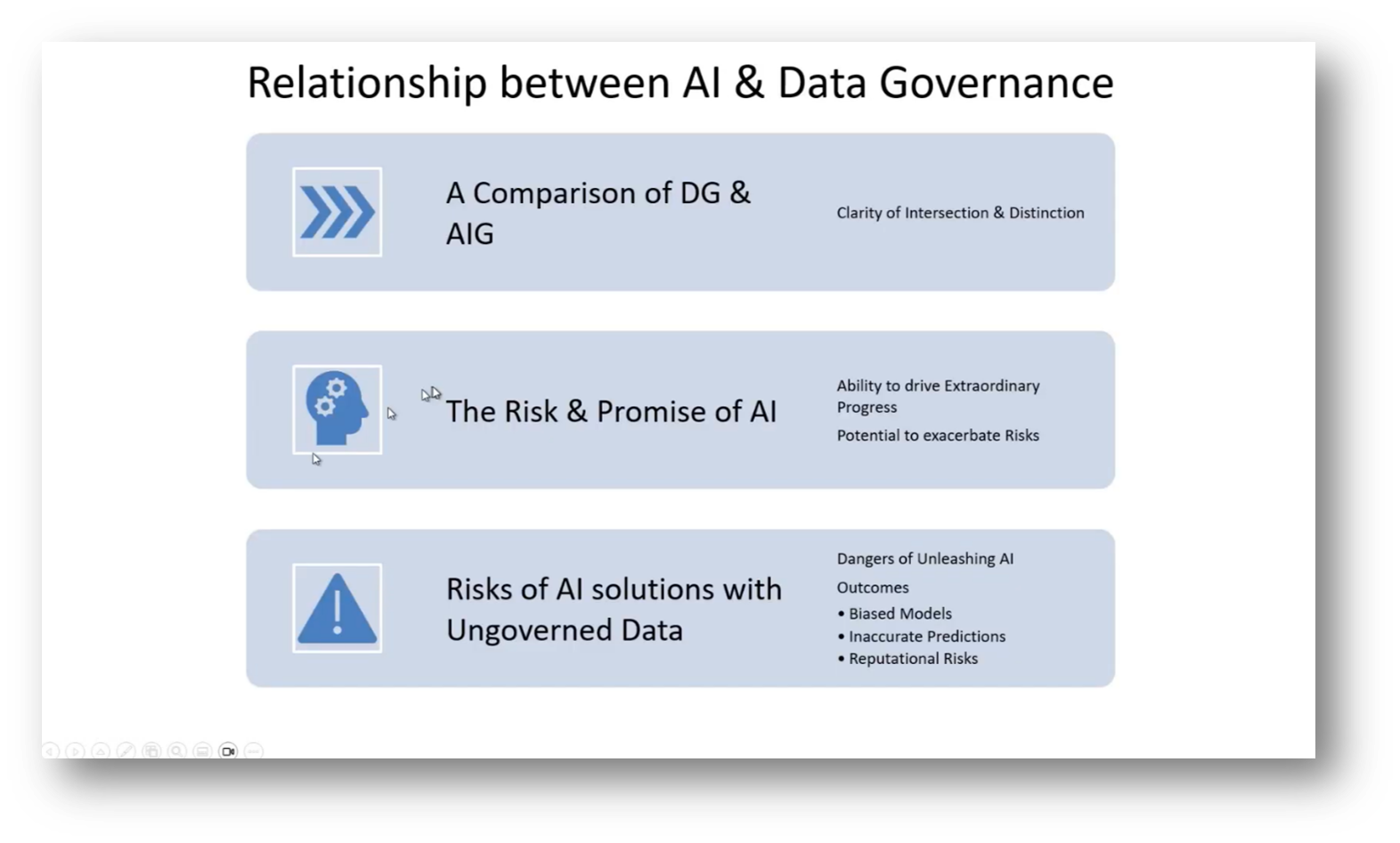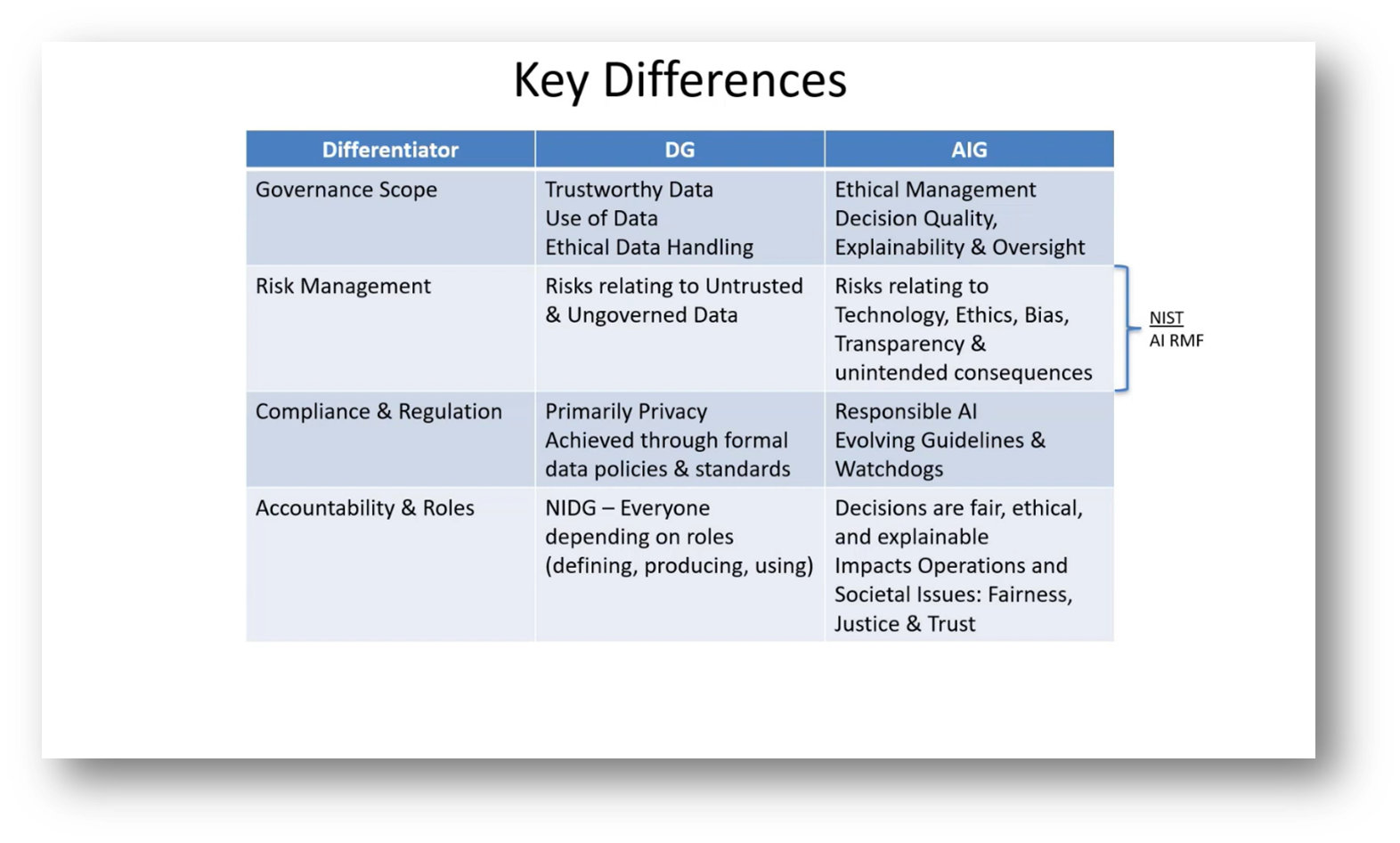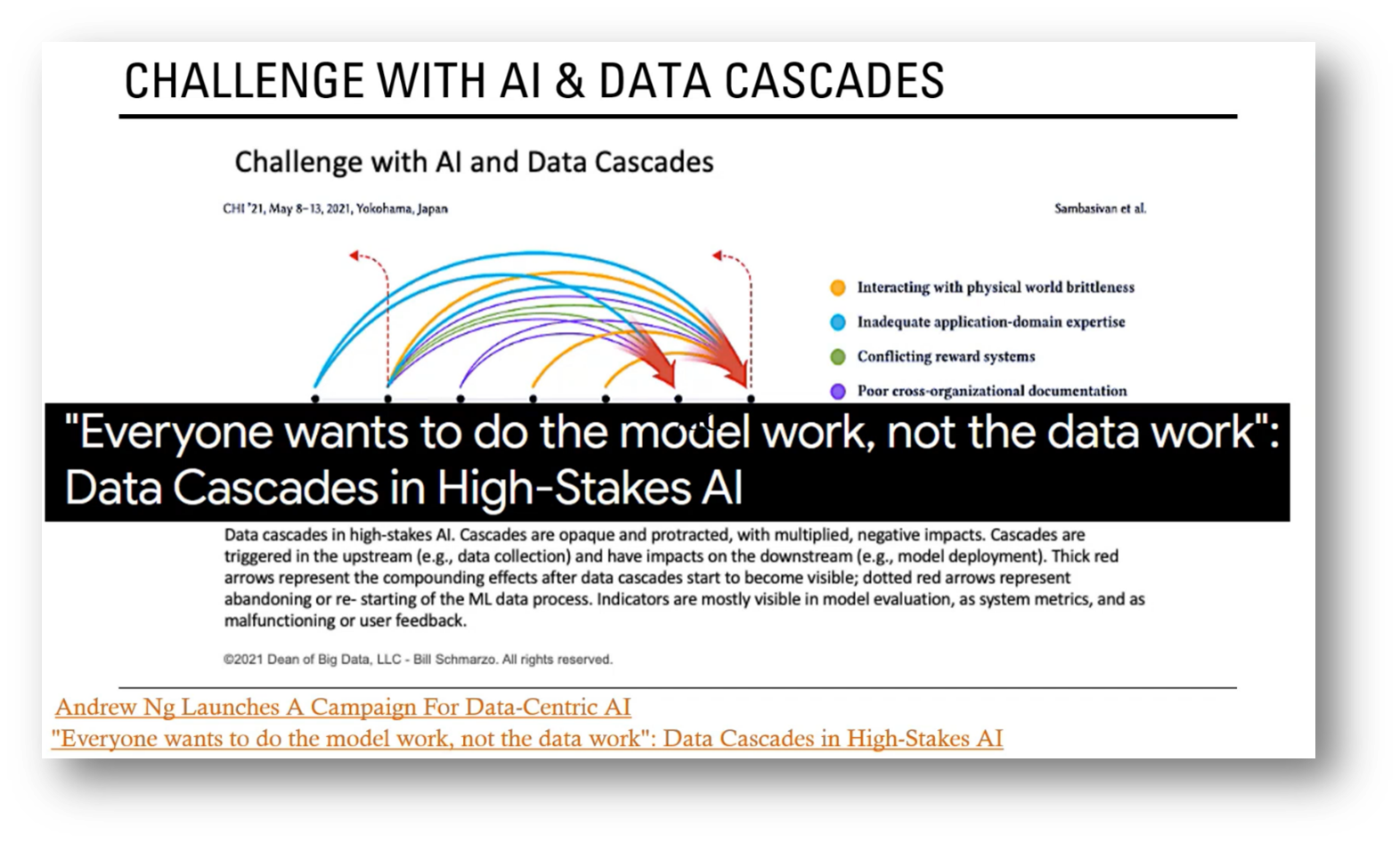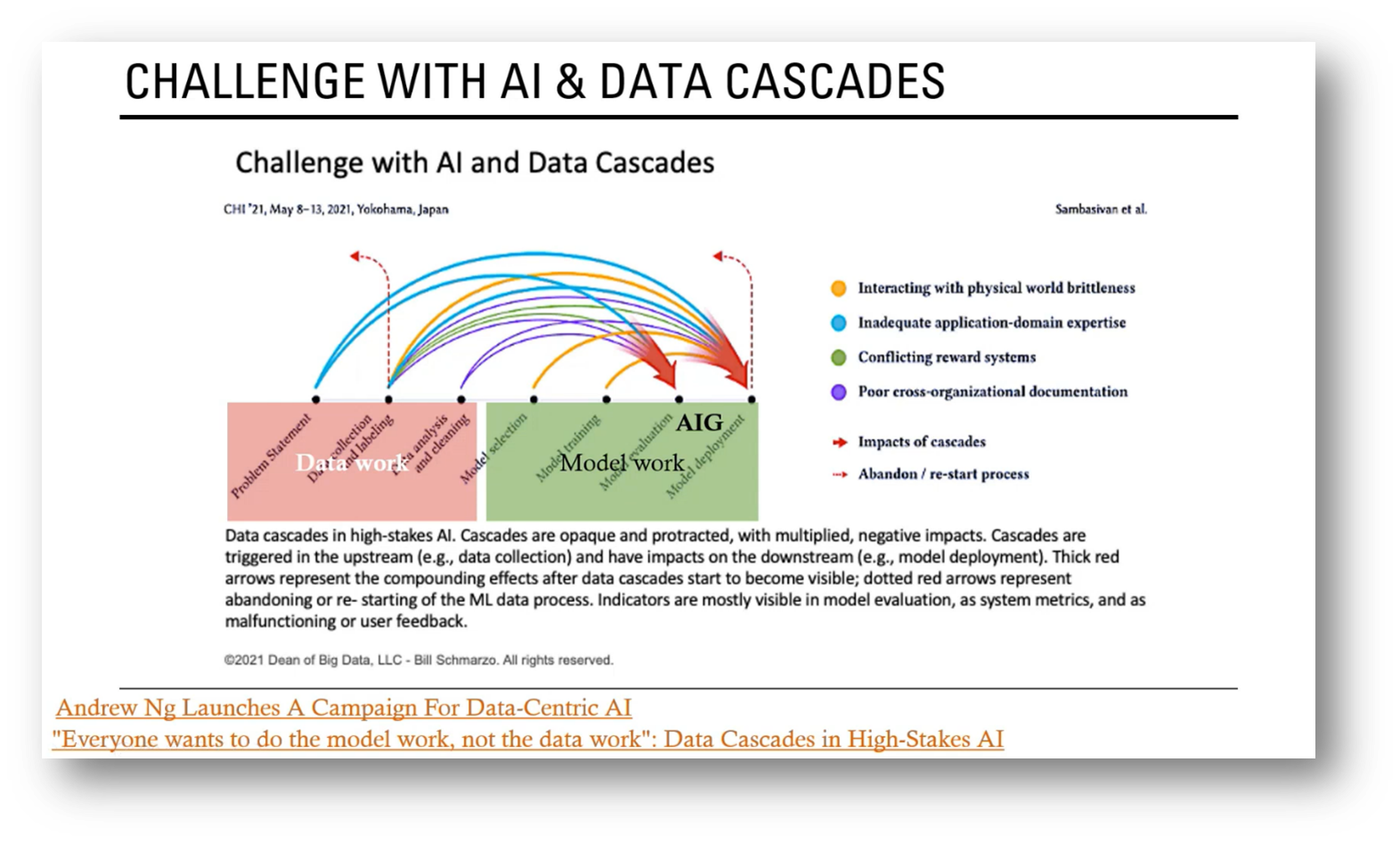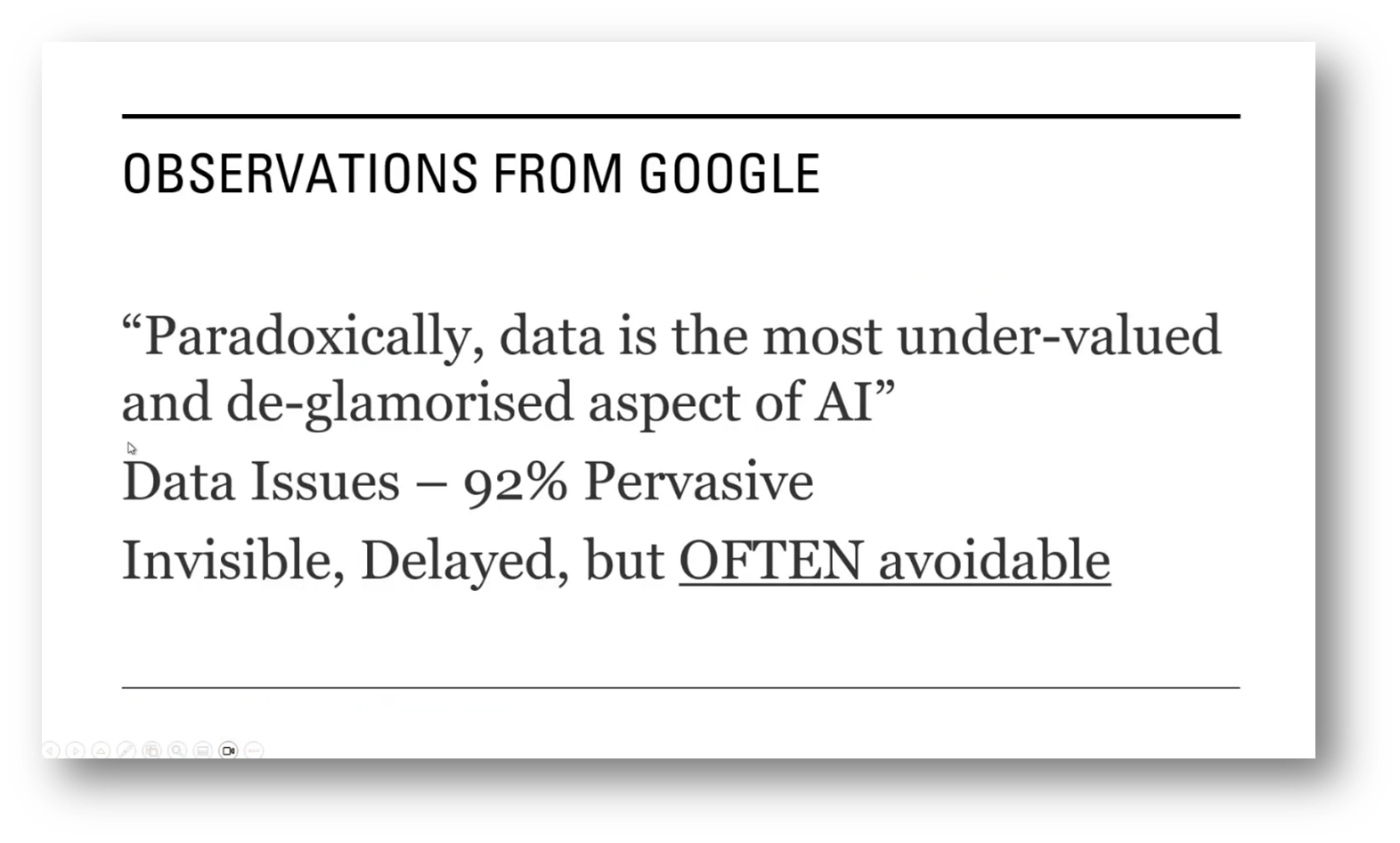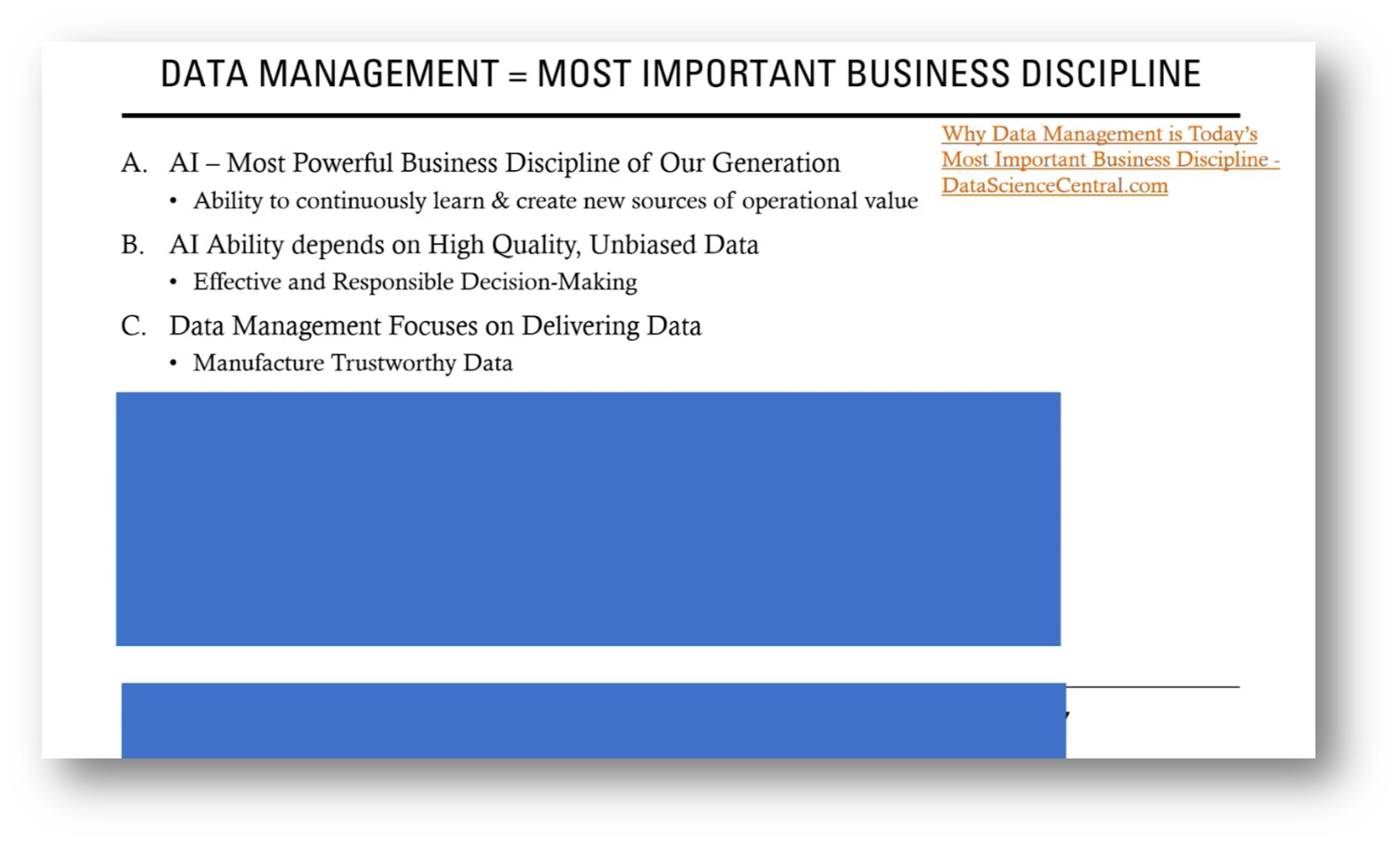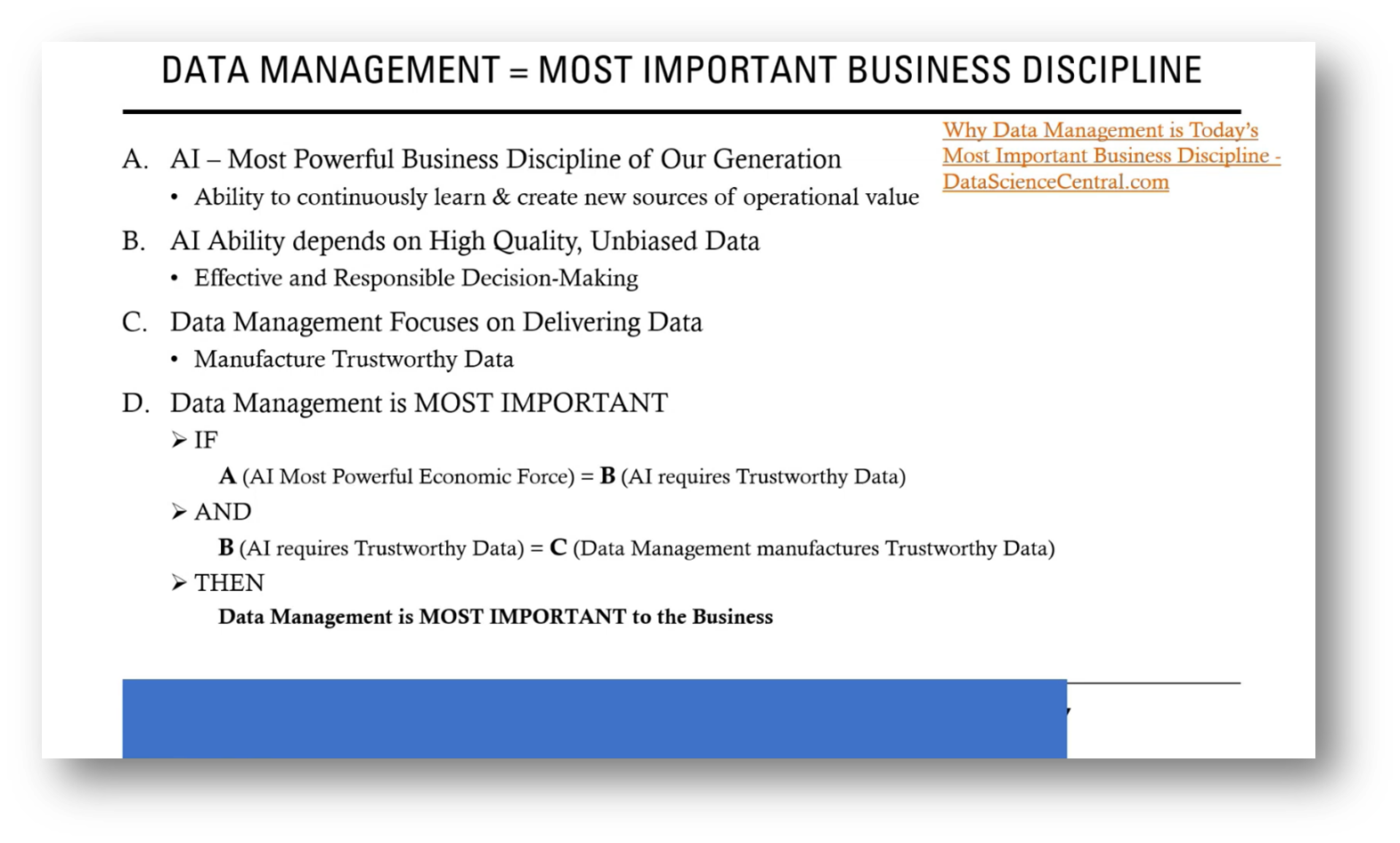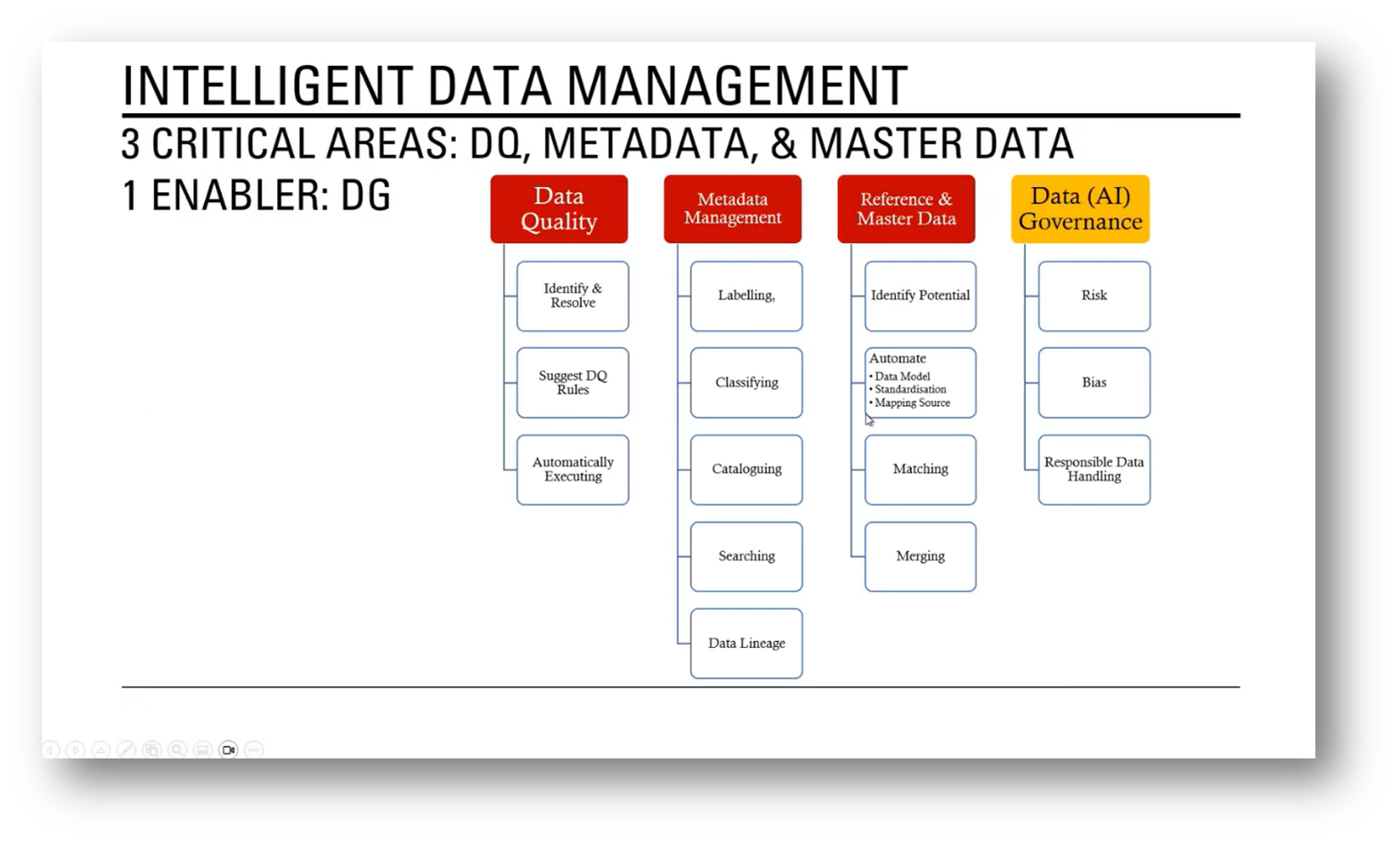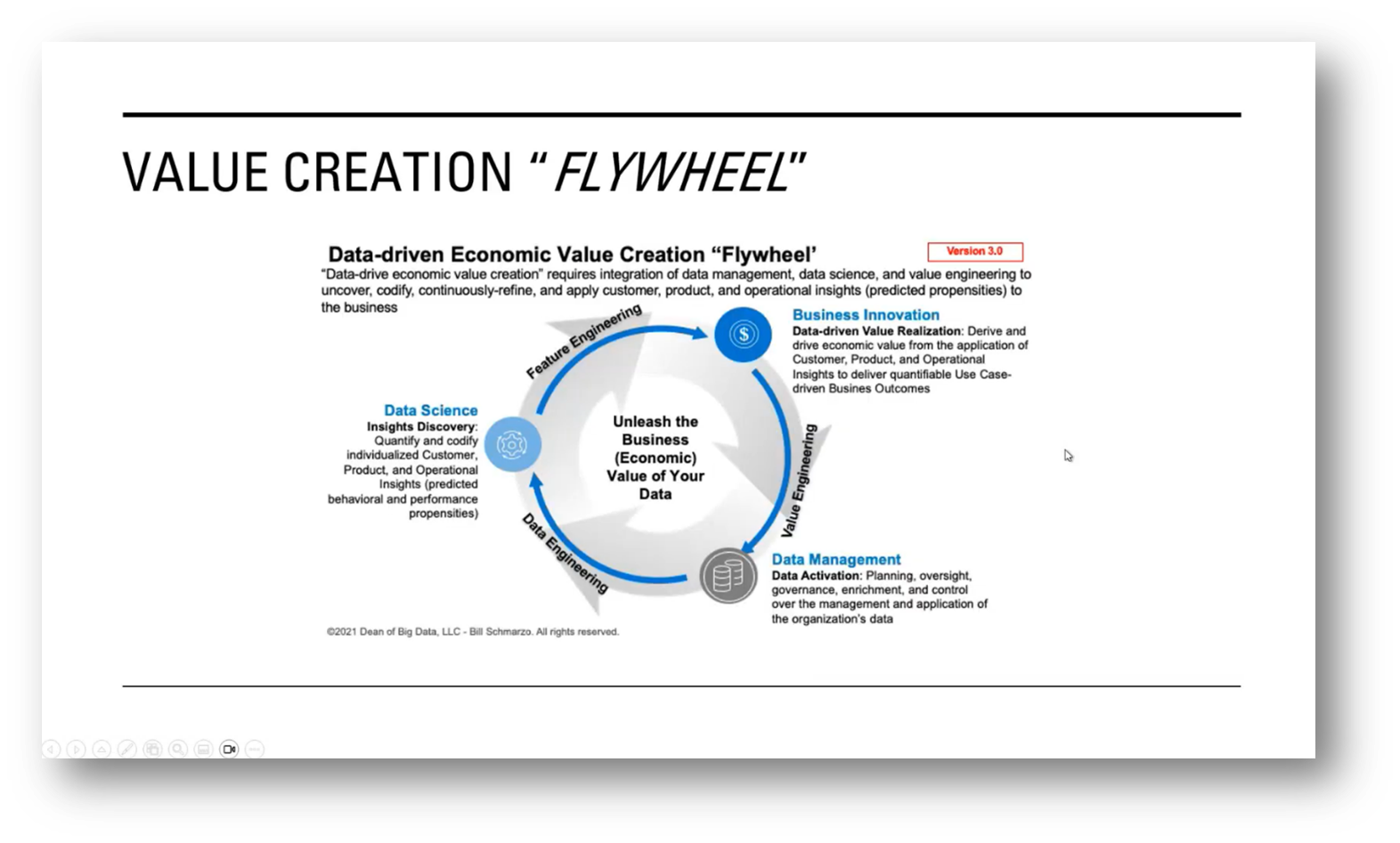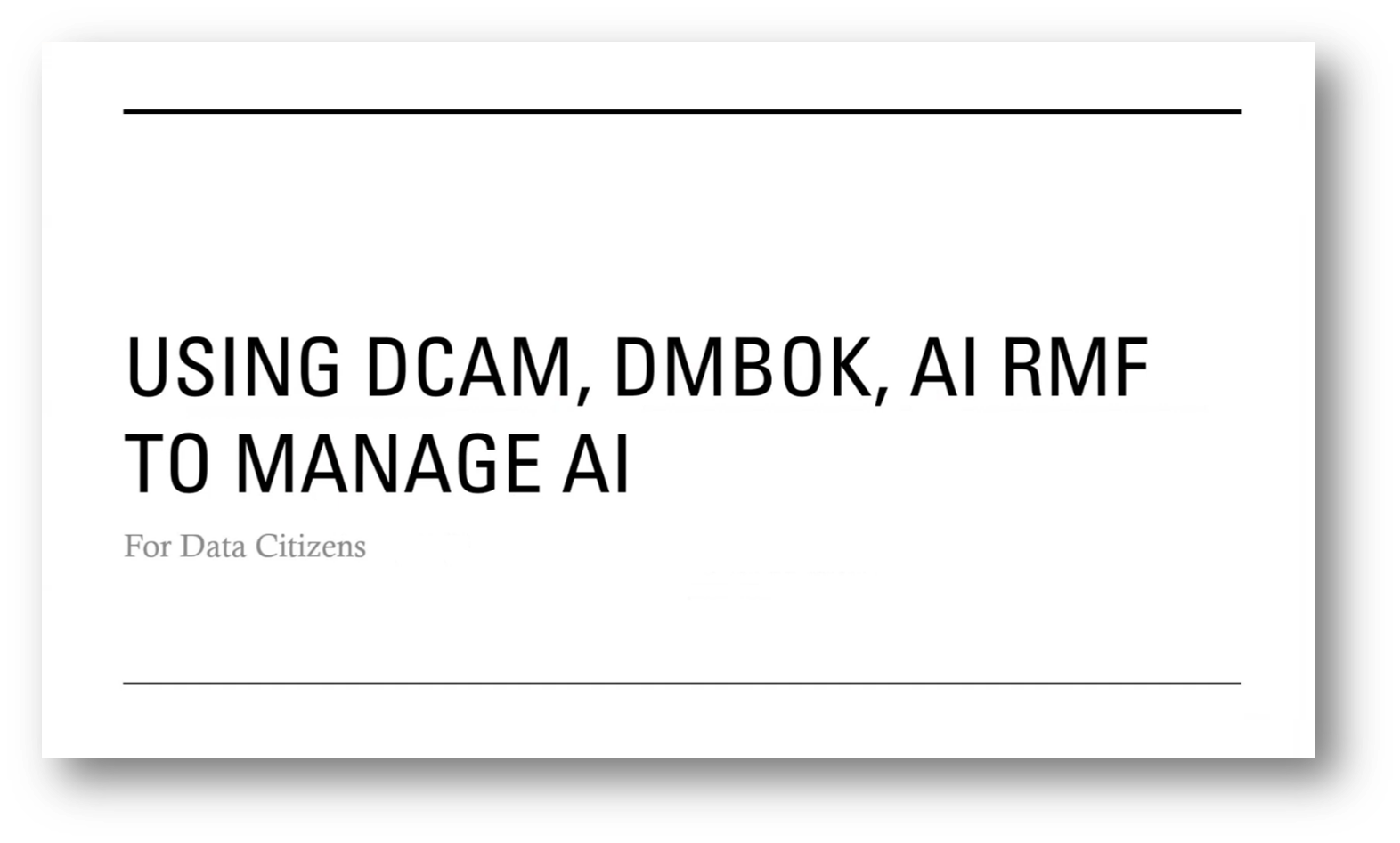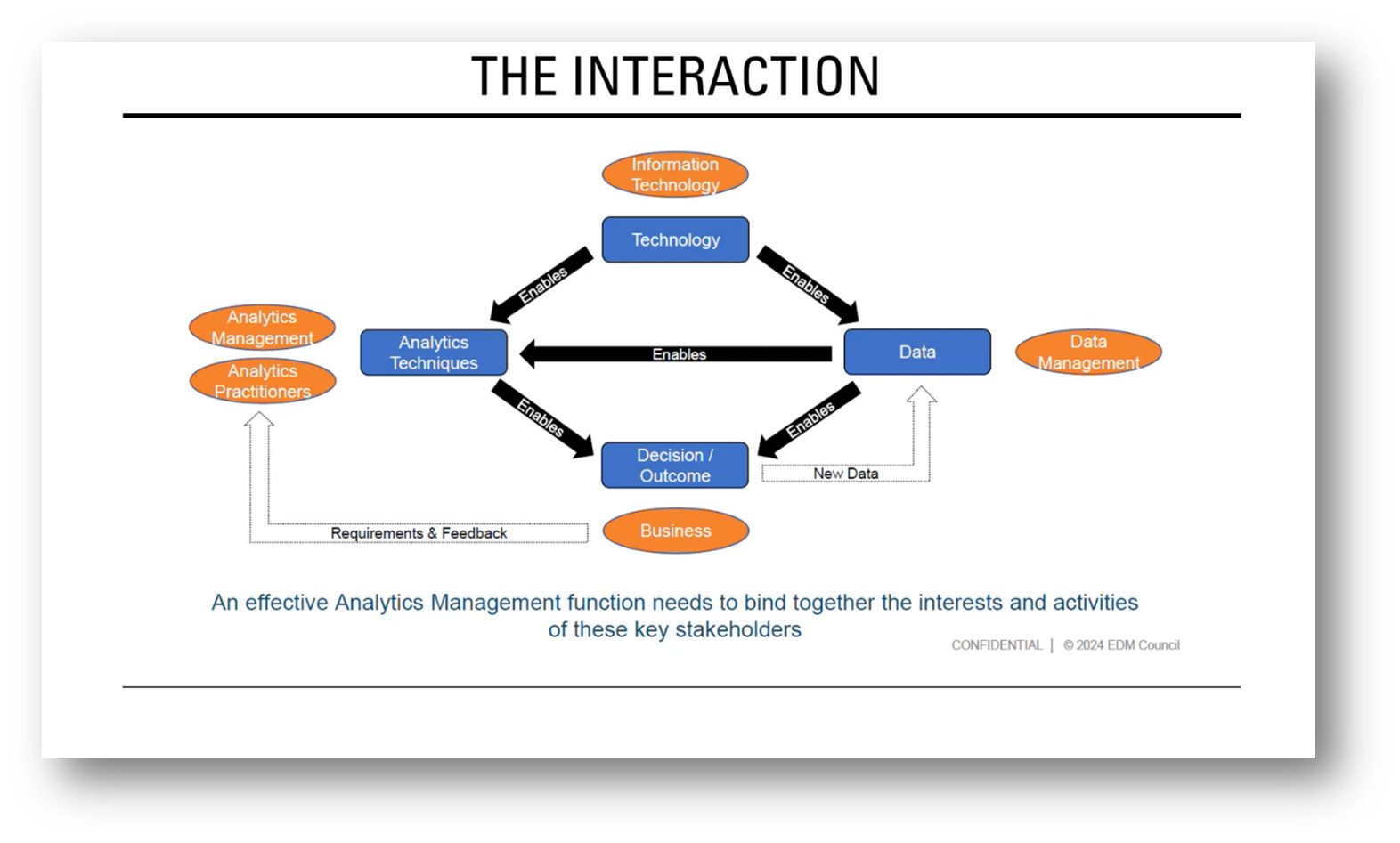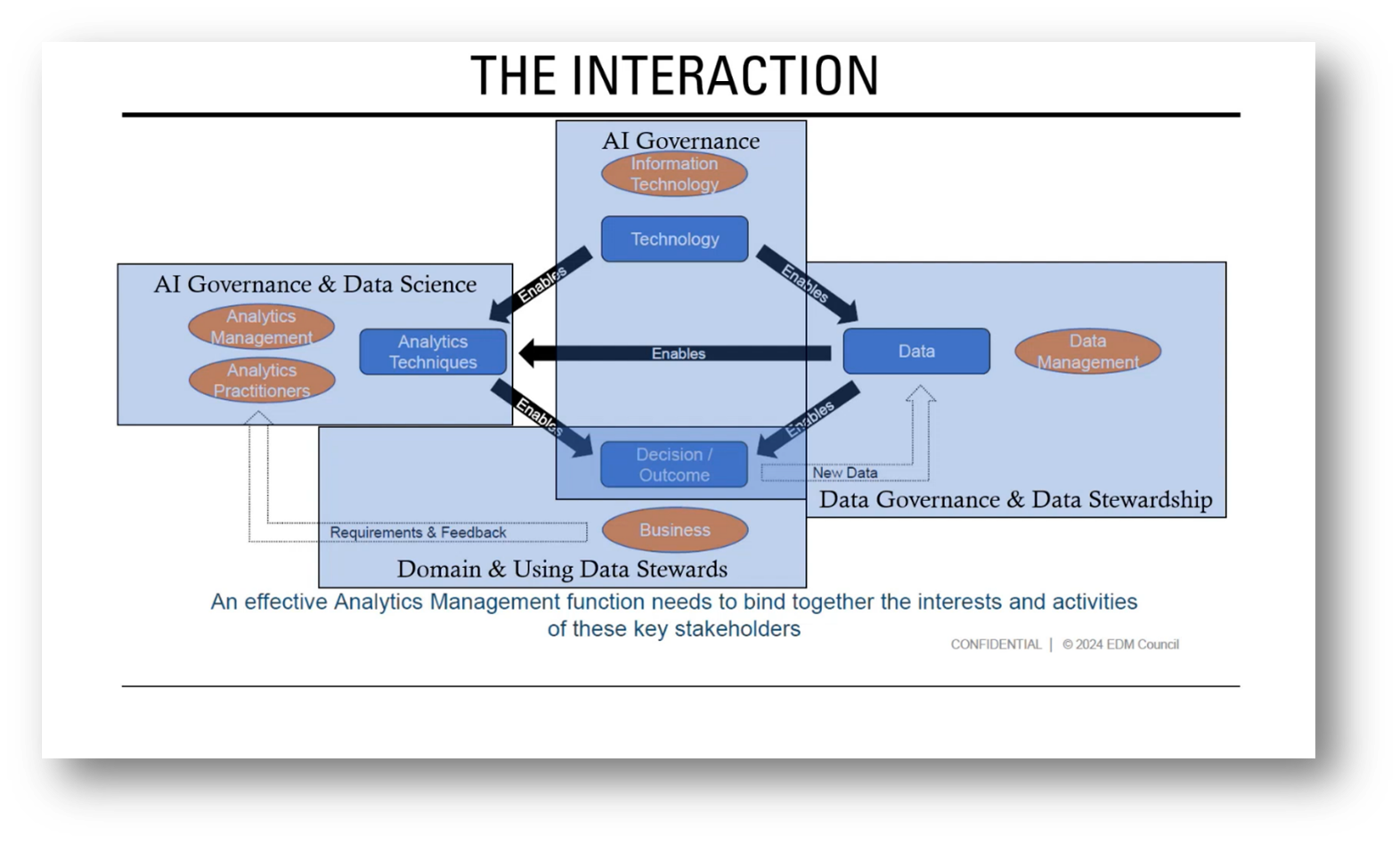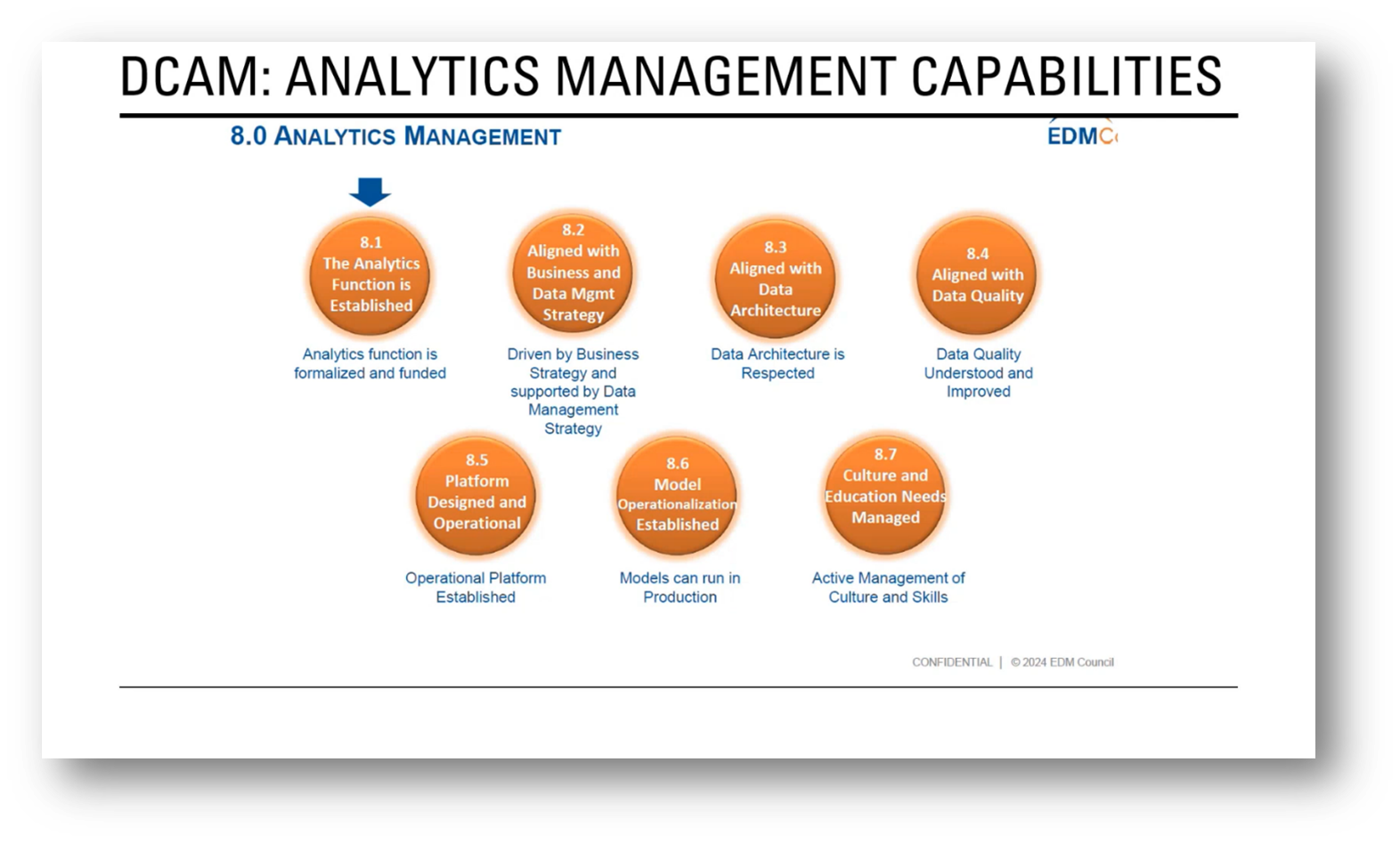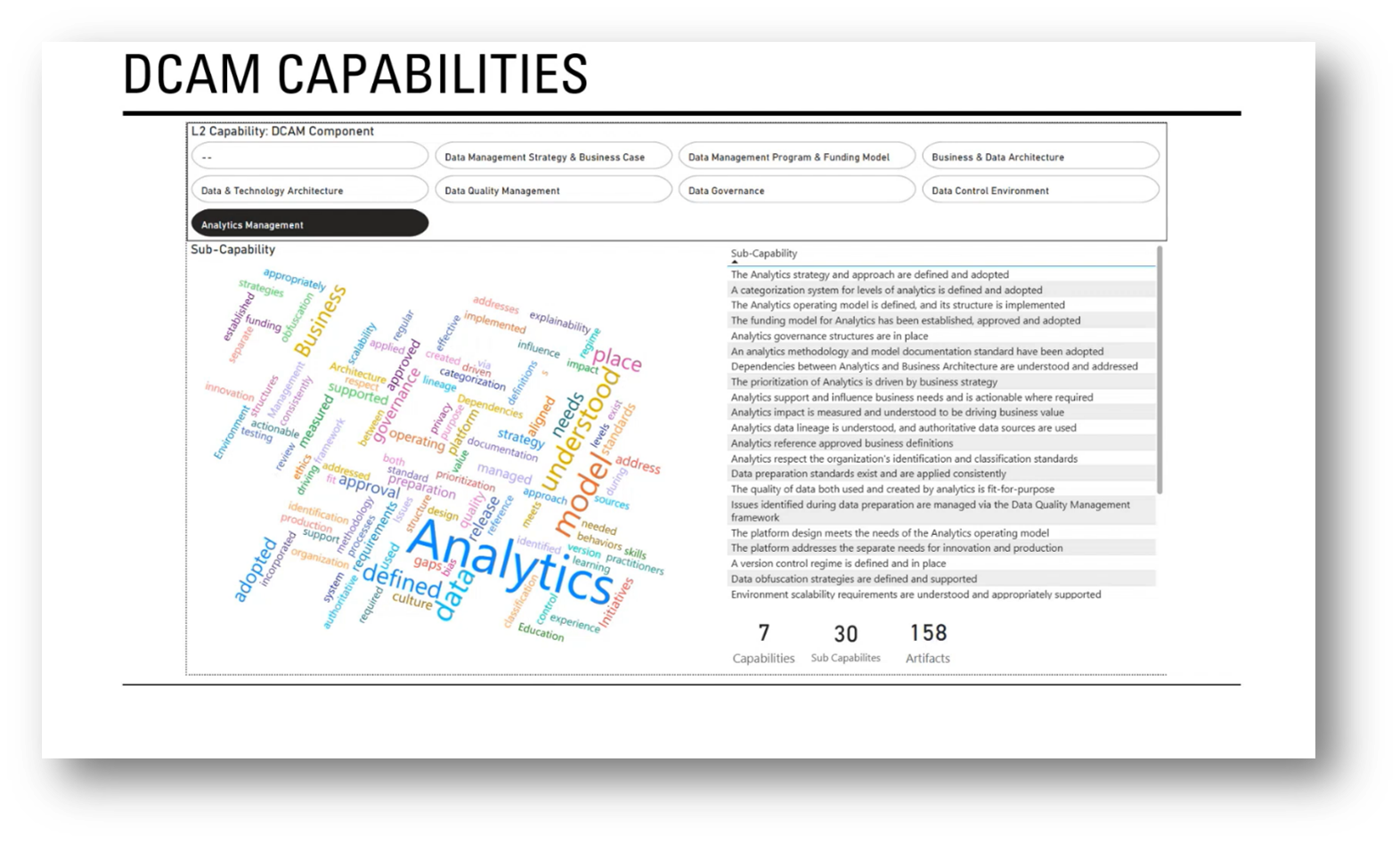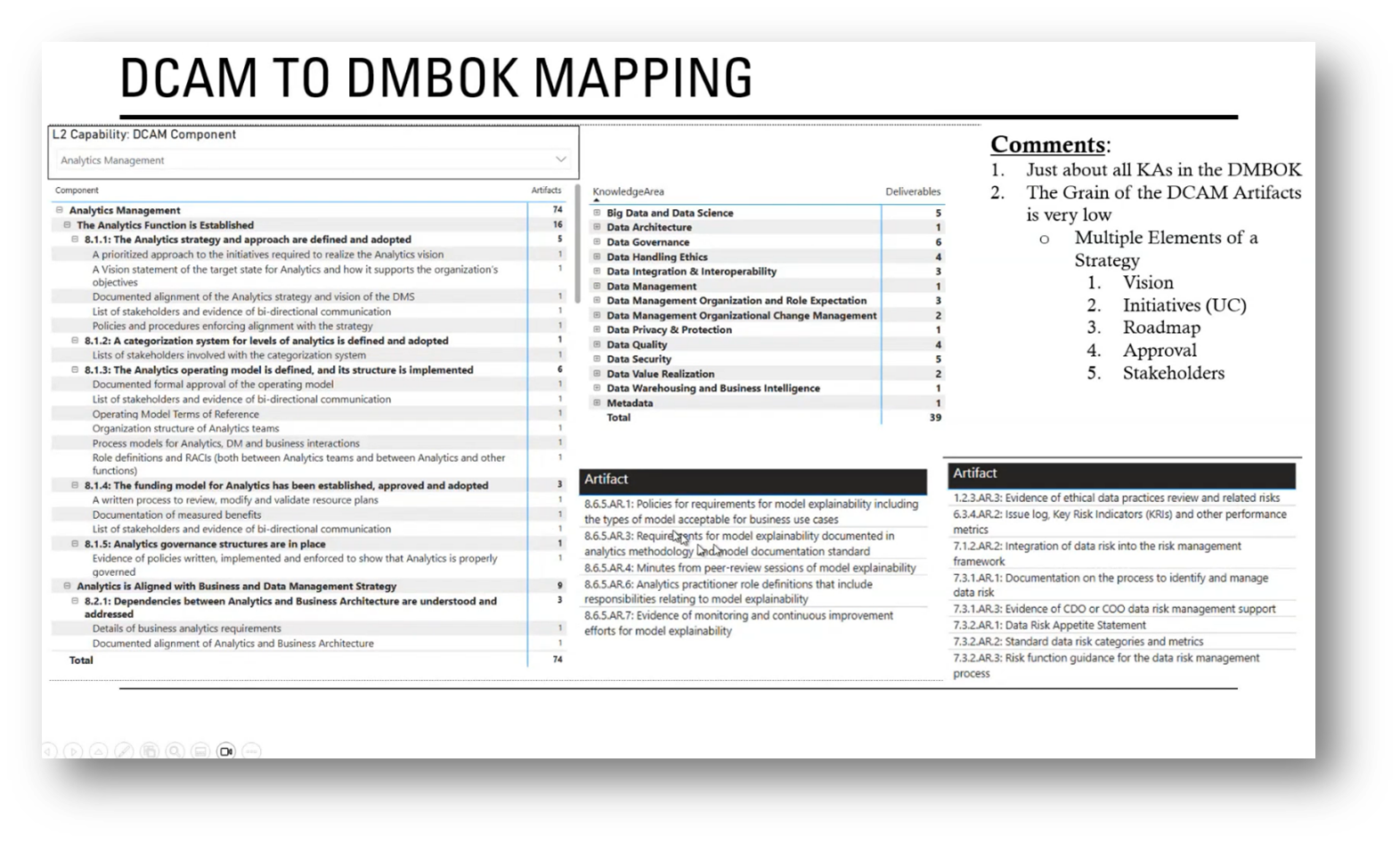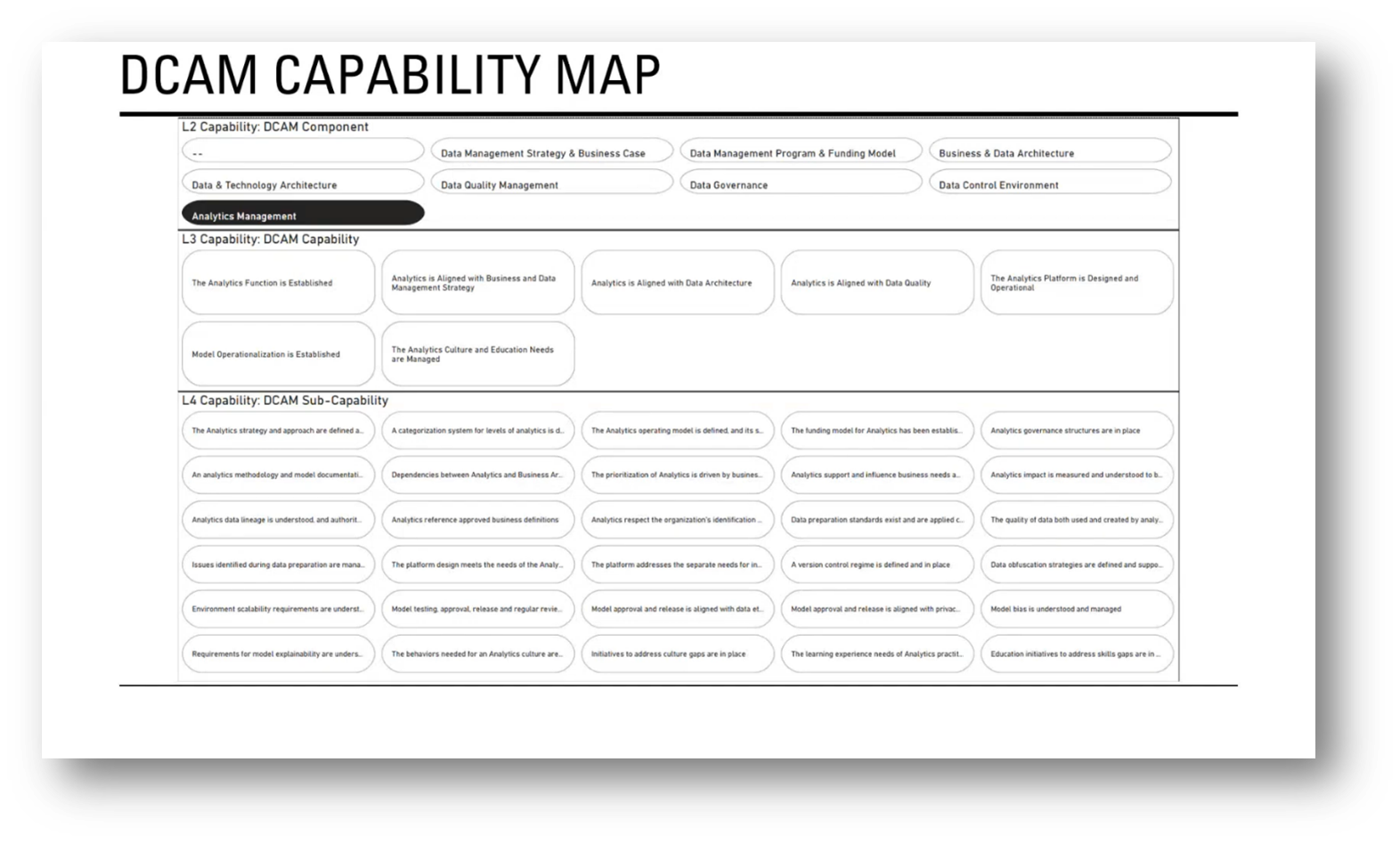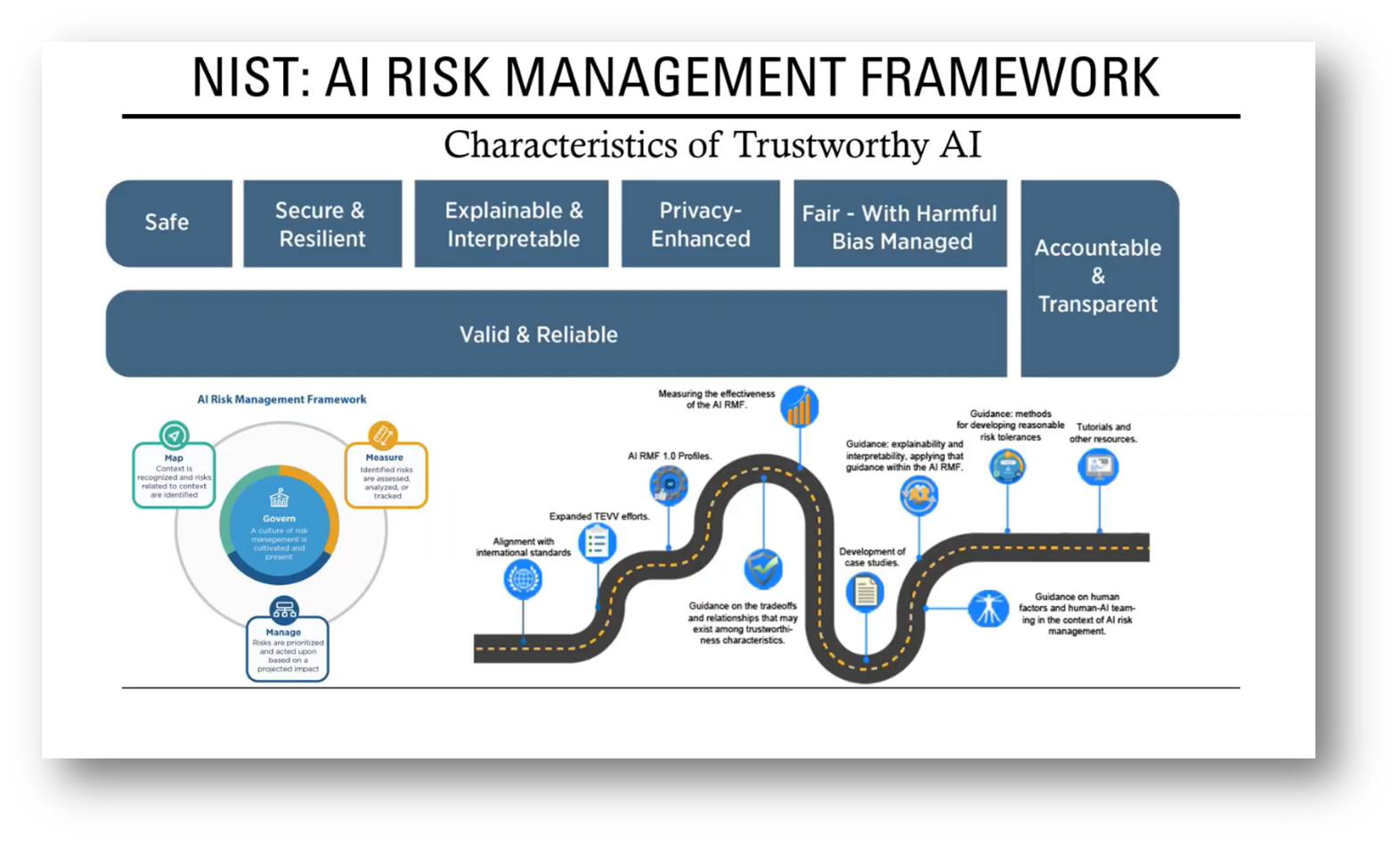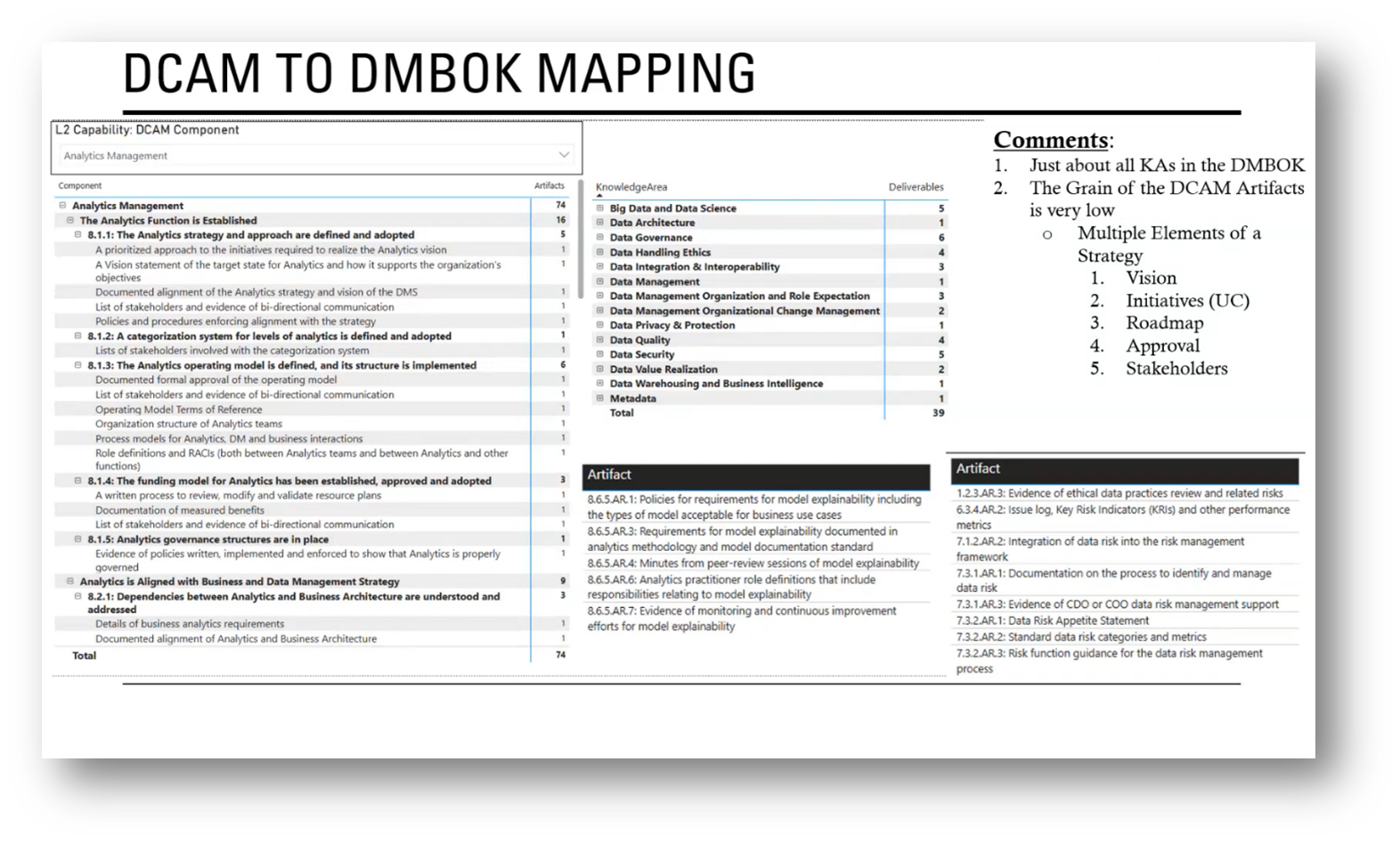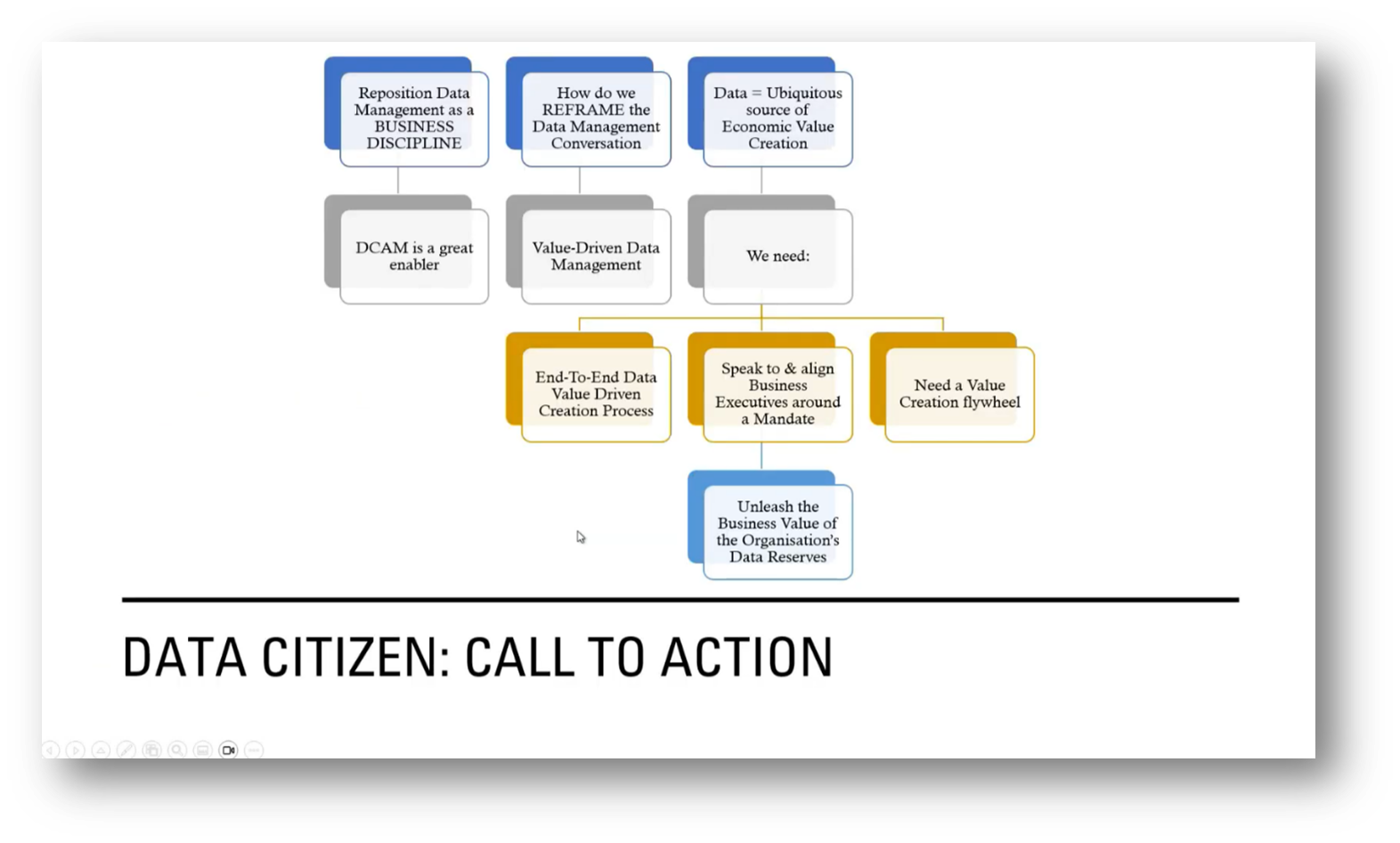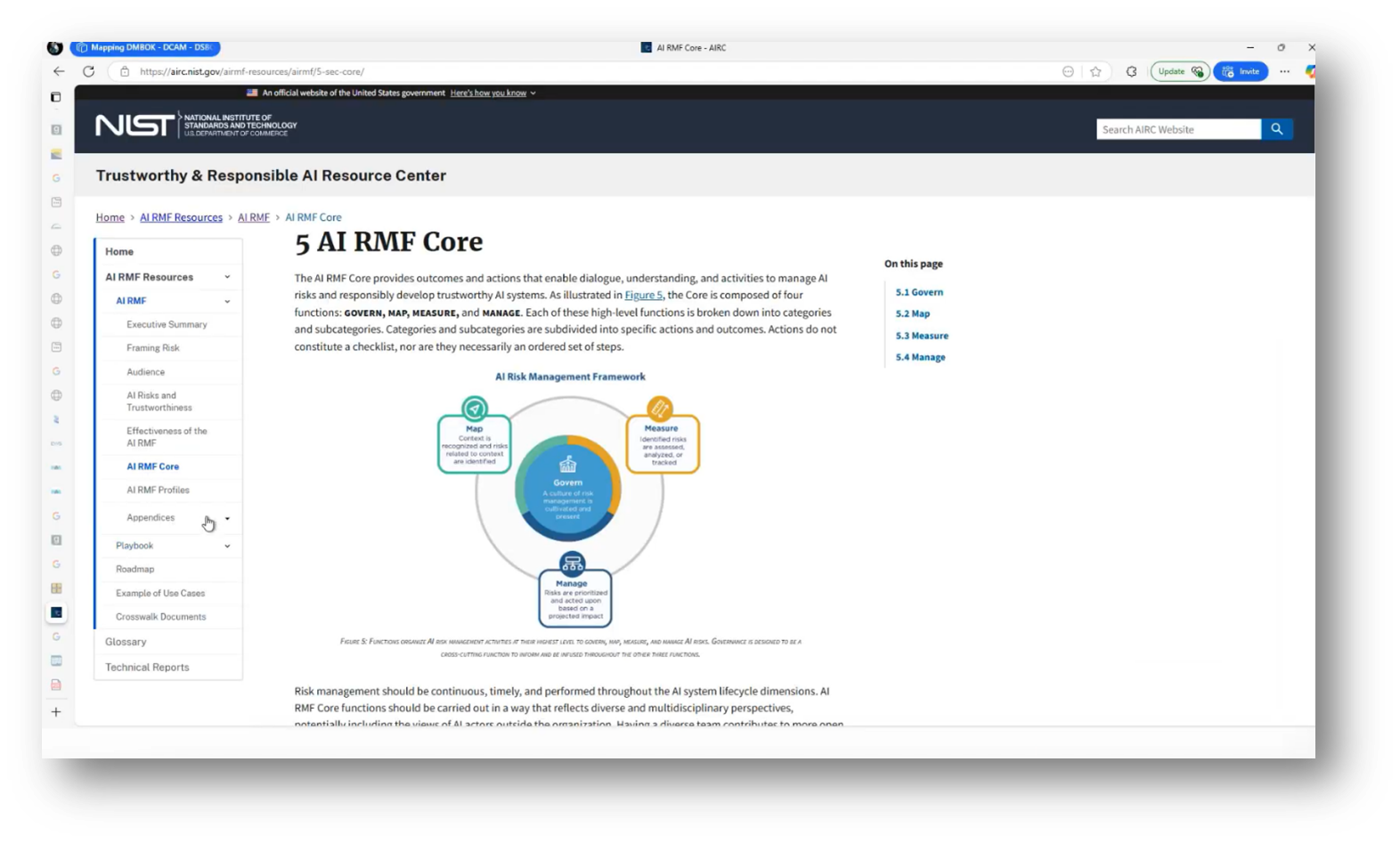Integrating DMBOK®2 and DCAM for Enhanced Data Management in AI for Data Citizens
Executive Summary
This webinar outlines the critical intersection of data management frameworks and AI governance as organisations navigate digital transformation. Howard Diesel emphasises the need for a balanced approach that integrates data quality and governance in AI systems to enhance decision-making and risk management. Additionally, the webinar includes Key aspects such as the role of data stewardship in ensuring business value, addressing challenges in AI application development, and leveraging DCAM capabilities for effective analytics management. Furthermore, the importance of AI governance in both technological and business contexts is highlighted, underscoring its significance in navigating the complexities of today’s data-driven landscape.
Webinar Details
Title: Integrating DMBOK®2 and DCAM for Enhanced Data Management in AI for Data Citizen
Date: 27 March 2025
Presenter: Howard Diesel
Meetup Group: African Data Management Community Forum
Write-up Author: Howard Diesel
Contents
Data Management Frameworks and Data Citizens
Implementation of AI Governance
Intersection of Data and Digital Transformation
Understanding AI Governance
Balancing AI Governance and Data Management in Digital Transformation
Role of AI Governance in Technology
Role of AI Governance in Business
Risk Management and Governance
Data Governance and the Importance of Quality Data in AI Systems
Challenges in AI Application Development
Data Management in AI and the Importance of Business Value
Data Management and AI in Social Data
Data Governance, AI and Decision-making
Role of Data Stewardship in AI and Data Management
DCAM Capabilities for Analytics Management and Data Governance
Data Management and Risk Management in the Business
AG Application and its Potential for Guidance in Assessments
The Role of Data Quality and Data Management in AI
Data Management Frameworks and Data Citizens
Howard Diesel opens the webinar and shares his focus. The webinar will explore the concept of data citizens, which include data stewards, producers, and users, such as data scientists, who play a critical role in the data life cycle and value generation. Howard highlights the various data management frameworks, particularly the Data Management Capability Assessment Model (DCAM) at the business architecture level that integrates stakeholders, value propositions, and capabilities with other maturity frameworks like the National Data Index (NDI) and Gartner, emphasising the effectiveness of data governance procedures. The need to align these frameworks with specific organisational contexts is stressed, noting Saudi Arabia's robust set of frameworks, including ethical AI considerations.
The presentation, Howard notes, will underscore the importance of linking DCAM with policies, procedures, and technology governance, particularly with emerging Artificial Intelligence (AI) risk management standards. Lastly, the webinar will focus on ensuring a cohesive approach to data management tailored to individual environments.
Figure 1 Data Citizens & Data Management Frameworks
Figure 2 "Bringing It All Together"
Implementation of AI Governance
The ongoing discussion around the necessity of AI governance has gained attention, particularly following John Bottega's recent video for the EDM Council, where he advocates for a unified governance framework for AI. Although there's a consensus on the importance of governance, it's crucial to distinguish between data governance and technology governance.
An attendee inquired about the foundational basis of a proposed meta model that included key elements like stakeholders, value propositions, and value streams, which is derived from the Business Process Model (BIZBOK). Howard notes that this model emphasises the structured approach to managing various components of business processes, supported by research in data management that outlines the relationship between discipline, practice, and policy within governance frameworks.
Figure 3 Data Citizens & DM Frameworks
Intersection of Data and Digital Transformation
Howard moves on to focus on the relationship between data management and digital transformation, particularly in the context of merging these two departments into one. Initially, he notes that the focus was application-centric, viewing data merely as raw material for digital applications that provided business value. This shifted with the emergence of the Data Management Body of Knowledge (DMBoK), which proposed a data-centric approach, emphasising data as central and digital as infrastructure. However, this model has not been widely effective, often overshadowed by the strong influence of Chief Information Officers (CIOs) over Chief Data Officers (CDOs).
Recently, the paradigm has evolved towards a 'digital first' approach, recognising data's foundational role while highlighting the importance of digital platforms and APIs in leveraging data for insights. This evolution indicates that digital transformation has become the prominent focus in organisational strategy.
Figure 4 Data & Digital: The Relationship
Figure 5 "Balancing "Data" & "Digital" "
Understanding AI Governance
The introduction of AI governance marks a significant evolution in digital management beyond just clean data. AI governance focuses on overseeing the entire life cycle of AI models, managing their transition into and out of production based on the quality of their recommendations. In contrast, data governance emphasises accountability, trustworthiness, and comprehensibility of the data. This distinction highlights the evolving frameworks required to effectively manage both AI systems and the data that informs them.
Balancing AI Governance and Data Management in Digital Transformation
AI governance highlights the shift from traditional data management to systems that influence digital decision-making, emphasising the need for a unified approach to data, technology, and AI. Additionally, AI governance is essential to ensure accountability in AI models, requiring ethical and privacy impact assessments during their development to address possible ethical concerns. As businesses embrace digital transformation, the role of the CIO becomes crucial in aligning data management and governance with digital strategies. This balance is necessary for making informed decisions and delivering value, especially as digital initiatives increasingly take precedence over traditional data management practices.
The organisations face complexities in integrating data, digital, and technology, due to being hindered by internal silos. Additionally, Howard emphasises the role of the CIO in shaping the organisation's approach, whether it's application-centric, digital-first, or focused on digital transformation. One Attendee adds that a CIO's perspective on data as mere exhaust, indicating a need for clarity in how data is perceived within the organisation.
Howard then touches on the challenges of organisational change management and the varying degrees of agreement on the value of data as opposed to the more abstract concept of digital transformation. He notes that the need to drive data centricity is essential, as it resonates more universally within organisations, prompting a shift towards understanding its value and delivery.
Figure 6 Application-Centric
Figure 7 Digital Transformation
Figure 8 Balance "Data" & "Digital"
Role of AI Governance in Technology
AI governance is increasingly recognised as a critical success factor in the development and implementation of technology, similar to cybersecurity. It focuses on managing the risks associated with AI systems that automate decision-making processes. As software developers create applications—like customer data platforms or recommendation systems on platforms like Spotify—it's essential to ensure that these systems operate under a robust governance framework. This involves understanding the role of human oversight in automated recommendations and maintaining clean, reliable data. Distinguishing between AI governance and data governance is crucial, as both play significant roles in the effectiveness and safety of AI technologies.
Figure 9 AI & Data Governance
Figure 10 AI Governance Success Factors
Role of AI Governance in Business
AI governance provides essential frameworks for organisations to extract business value from their initiatives while ensuring that AI tools function safely and ethically. For instance, platforms like Spotify employ customer behaviour data to make personalised recommendations, enhancing user engagement and delivering value. It's crucial to recognise the intersection and distinction in this field—where the initial model development focuses on ethical considerations, and AI governance then steps in once the model is operational, monitoring its impact and the decisions being made.
Figure 11 AI Governance Success Factors Pt. 2
Figure 12 Relationship between AI & Data Governance
Risk Management and Governance
The intersection of AI and risk management is crucial for organisations to understand, particularly through the lens of frameworks developed by NIST, known for its expertise in risk management. AI systems hold remarkable potential for driving advancements in business through hyper-personalization, allowing for tailored interactions with individuals based on their specific behaviours rather than generalised personas. However, this technological promise also brings significant risks, including biased models, inaccurate predictions, and potential reputational damage. Consequently, effective AI governance is essential, requiring continuous monitoring and comprehension of the impact on customers and stakeholders alike.
Data Governance and the Importance of Quality Data in AI Systems
Recent advancements in integrating data management policies into chatbots and large language models (LLMs) have highlighted the importance of quality data for sustainable generative AI. By utilising retrieval-augmented generation (RAG) to input comprehensive data policies and procedures, business users can more effectively navigate processes and standards. This approach emphasises the necessity of maintaining a steady stream of high-quality, governed data, particularly for unstructured data, to avoid confusion and inaccuracies in AI responses.
The effectiveness of AI is directly tied to the quality of the input data, a lesson learned from business intelligence (BI) practices. Furthermore, ineffective data governance can lead to biases and operational challenges, underscoring the vital need for alignment between AI systems and data governance to ensure accurate recommendations and customer engagement.
Digital decision-making relies on AI systems to make rapid decisions, necessitating effective AI governance to manage the model life cycle and ensure ethical decision quality. This delineation between AI governance and data governance highlights the importance of maintaining clean, trustworthy data in the model design phase, while the AI governance framework addresses aspects like decision oversight and explainability.
AI serves as an application of data rather than being governed by it; hence, it should integrate seamlessly into existing data control environments like DCAM without requiring constant revisions. As noted by industry experts, having robust data foundations and aligned business processes is crucial for leveraging AI effectively while ensuring that the foundational elements of technology remain stable and adaptable for future advancements.
Figure 13 AI & DG
Figure 14 Intersection
Figure 15 Key Differences
Challenges in AI Application Development
Howard highlights that a key difference between traditional applications and AI is how they handle data quality. While applications can reload data and correct errors later, AI systems learn from both good and bad data, which complicates the need for rigorous quality checks. With AI, particularly in the context of building a chatbot utilising RAG on top of an LLM, managing content quality is critical to prevent issues like hallucination, which can arise from incorrect data or ambiguous prompts. Ongoing monitoring is essential to detect model drift, ensuring that the correlations among features remain intact and that the AI delivers accurate recommendations.
Data Management in AI and the Importance of Business Value
The presentation focuses on the critical role of data governance in AI systems, emphasising the need for controlled and trusted data sources to ensure effective and responsible AI outcomes. Howard highlights the importance of data management as a recognised business discipline, encouraging businesses to integrate data management into their frameworks.
Howard moves on to focus on the concept of "data cascades," highlighting the critical importance of effective data management alongside model development in AI and analytics. He points out that many practitioners are focusing on models rather than the foundational data work necessary for their success.
Observations indicate that 92% of issues in AI stem from data quality, lineage, and understandability, with many problems becoming evident only after a system is in production, making them costly to address. Additionally, the effectiveness of AI is heavily reliant on high-quality, unbiased data; without it, AI initiatives are likely to fail. Therefore, prioritising trustworthy data management is essential for delivering business value and ensuring the overall success of AI systems.
Figure 16 "Data Management = Most Important Business Discipline"
Figure 17 Challenges with AI & Data Cascades
Figure 18 Challenges with AI & Data Cascades Pt.2
Figure 19 Observations from Google
Figure 20 Why Data Management is an Important Business Discipline
Data Management and AI in Social Data
Effective data management focuses on key aspects such as data quality, metadata management, and the identification of reference and master data, particularly in contexts involving social data. This involves the processes of matching and merging data to create a cohesive understanding of entities like customers and products. Artificial intelligence plays a crucial role by addressing risks and biases and promoting responsible data handling.
The data value creation process is akin to a flywheel, where data engineering leads to data science and feature engineering, enabling informed decision-making. In practical scenarios, such as working with customer data, the challenges of match and merge processes include the potential rejection of records and the need for survivorship strategies to reinstate records if an existing customer is mistakenly classified as new. Ultimately, effective merging strategies should facilitate the creation of linked records rather than forcing convergence into a single record while also ensuring the capability to roll back changes when necessary.
Figure 21 Why Data Management is an Important Business Discipline Pt.2
Figure 22 Intelligent Data Management
Figure 23 Value Creation "Flywheel"
Data Governance, AI and Decision-making
Howard highlights the distinction between data governance, data stewardship, and AI governance within the decision-making cycle. He emphasises the importance of data stewards in evaluating the decisions made by systems, ensuring those decisions are justified and correcting any mistakes by providing feedback to data scientists and analytics teams. This framework, informed by Ben's insights from DCAM training and presentations from the EDM Council, illustrates how high-quality, trusted data is crucial for decision support and can eventually lead to automation within organisations. The separation of AI governance from data governance and stewardship was noted as an essential aspect of effectively managing these roles and responsibilities.
The presentation moves on to the importance of using the Kniffin framework to understand data states in digital decision-making, emphasising the need for known questions and answers, akin to a recipe for effective decision-making. Concerns are raised about model drift due to changing contexts, which may lead to outdated causation becoming mere correlation, potentially complicating data quality and feature engineering. Traceability is critical, especially in regulated environments like electricity networks, where reliance on automated decisions must be explained. Consequently, data scientists focus constantly on feature engineering to maintain accurate relationships between features as contexts evolve, ensuring that decision-making remains reliable and transparent.
Figure 24 Using DCAM, DMBOK, AI RMF to Manage AI
Figure 25 The Interaction
Figure 26 The Interaction Pt.2
Role of Data Stewardship in AI and Data Management
A new role is emerging in the field of data management and artificial intelligence, focusing on data quality assurance and oversight, which currently does not exist in its entirety. Traditionally, statisticians have analysed the relationships between features, but as new contexts and environments evolve, existing models may not perform effectively, necessitating a supervisory role to continually assess and address these changes.
Domain data stewards, such as customer-focused individuals, play a crucial role in identifying when models fail by leveraging their in-depth understanding of specific business areas. This expanded framework aligns with the DCAM analytics management model, introducing complexity as organisations must clarify roles and responsibilities across different data domains while ensuring accountability in decision-making processes.
Howard highlights the challenges organisations face in managing data effectively, particularly in the context of AI governance and organisational change management. Bob Seiners' approach emphasises leveraging existing data users and supplementing them with main data stewards—subject matter experts across various business processes. Additionally, a critical concern raised is the issue of dark data, which refers to ungoverned data that accumulates without oversight, often stored in shared folders and platforms like SharePoint. This dark data can lead to significant problems due to its invisibility and lack of governance, complicating efforts to utilise AI and advanced analytics effectively.
DCAM Capabilities for Analytics Management and Data Governance
The presentation moves on to the capabilities of DCAM for analytics management, particularly in version 2, highlighting its extensive mapping to the DMBoK. Key aspects include alignment with business data management strategies, established functions, data architecture, quality, and approved platforms, alongside operational models and governance. Despite its comprehensive nature—integrating artifacts from strategy to stakeholder engagement—it poses challenges in mapping due to its extensive scope, potentially leading to concerns about whether it should encompass all these elements.
Howard emphasises that executives must recognise that investing in analytics goes beyond mere reporting; they need to understand the full spectrum of components involved. Moreover, it's vital to establish data governance before advancing to analytics, as DCAM consists of distinct compartments for different capabilities, including data quality.
Effective AI governance is essential for organisations leveraging artificial intelligence to ensure safe, ethical, and valuable outcomes. As software developers create applications like customer data platforms and recommendation systems, robust governance frameworks must be in place to oversee automated decision-making processes. This involves a clear distinction between AI governance and data governance, where the former monitors the operational impact of models initially developed with ethical considerations.
Given the significant potential of AI for hyper-personalization, organisations must recognise the associated risks, such as biases and inaccuracies. Maintaining high-quality, governed data is crucial, particularly for unstructured data, to enhance AI effectiveness and prevent operational challenges. As AI systems make rapid decisions, they require rigorous data quality management, unlike traditional applications that can easily correct errors post-facto. Hence, integrating AI seamlessly into existing data control environments and aligning business processes is vital for leveraging technology effectively while ensuring stability and adaptability for future advancements.
Figure 27 DCAM: Analytics Management Capabilities
Figure 28 DCAM Capabilities
Figure 29 DCAM to DMBOK Mapping
Figure 30 DCAM Capability Map
Data Management and Risk Management in the Business
Microsoft Excel is widely used by business stakeholders for data analysis, often leading to challenges in data quality and discoverability. For instance, at a central bank, a lapse in updating risk ratings in multiple Excel spreadsheets exposed significant risks. This highlighted the importance of having a single authoritative source for master data.
The conversation around data management should focus on creating business value, as evidenced by connections between DCAM artifacts and risk management frameworks, which emphasise trustworthiness, accountability, and transparency in AI. To effectively communicate the role of data management, it should be reframed as a discipline aimed at driving economic value rather than merely handling data storage and processing.
To effectively realise data value, we must implement value-driven processes and ensure alignment with business executives and stewards. The goal is to leverage AI systems to enhance customer and stakeholder engagement, maximising the value derived from data. Collaboration among advocates is essential in articulating a comprehensive vision for clients, emphasising the need for a cohesive package of initiatives that enable AI implementation. Additionally, understanding data risks, including data privacy and security, is crucial as they are intertwined with how data is utilised to drive engagement and value. Overall, a holistic approach to managing data and AI will clarify objectives and support organisational change.
Figure 31 NIST: AI Risk Management Framework
Figure 32 DCAM to DMBOK Mapping
Figure 33 Data Citizen: Call to Action
AG Application and its Potential for Guidance in Assessments
In a discussion, attendees expressed excitement about an upcoming demo of a graph for an AG application scheduled for the 24th, emphasising the ease of implementation without coding, utilising available Python and R code examples. Additionally, Howard highlights the potential to integrate DCAM artifacts to facilitate guided assessments and inquiries, allowing for enhanced thought leadership in the subject matter. William confirmed that his questions were satisfactorily answered during the exchange.
The Role of Data Quality and Data Management in AI
Howard highlights the distinction between viewing data merely as a tangible resource and understanding it as a source of meaning, particularly within the context of data management and quality. He emphasises the challenge of communicating this difference, especially as AI continues to evolve. While the term "semantics" may resonate with a more educated audience, using the concept of "meaning" tends to be more universally understood. Additionally, Howard touches on how contextualising data—such as distinguishing a simple number from its relevance in a specific situation—can help clarify its significance. Finally, it stresses the vital role of data stewards in imparting knowledge and understanding about data, as they provide the necessary context and insights that contribute to its value.
The presentation then changed focus to the integration of AI in data management and quality control, particularly in the banking sector. As data volumes increase, traditional methods become insufficient, necessitating the use of AI to automate quality checks and enhance the understanding of new data sets. AI can aid in rebuilding metadata, applying data quality rules, and automating data classification, such as identifying privacy information.
The conversation highlighted the potential for AI to streamline day-to-day operations by embedding policies and procedures within data workflow, thereby increasing productivity and reducing ambiguities. This approach not only supports effective data management but also addresses conflict management by identifying inconsistencies in policies, ultimately enhancing the overall efficiency of data governance practices.
Figure 34 NIST Framework
If you would like to join the discussion, please visit our community platform, the Data Professional Expedition.
Additionally, if you would like to be a guest speaker on a future webinar, kindly contact Debbie (social@modelwaresystems.com)
Don’t forget to join our exciting LinkedIn and Meetup data communities not to miss out!


